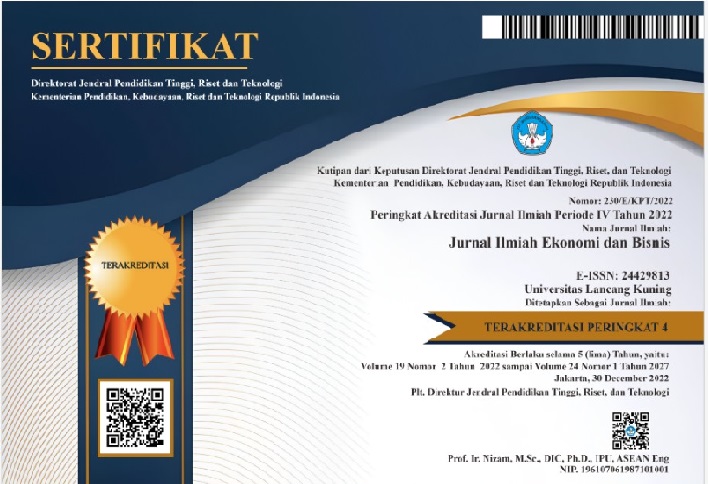DO FOREIGN FUNDS AFFECT INDONESIAN CAPITAL MARKET LIQUIDITY?
DOI:
https://doi.org/10.31849/jieb.v18i2.6313Keywords:
liquidity; trading volume; Amihud Illiquidity Ratio; bid ask spread; exchange rate.Abstract
Trading Volume (Liquidity) is the perfect complement to returns. Therefore, research regarding volume becomes an important thing in the capital market. Various factors that influence the Liquidity (TV) are bid-ask spread; interest rates, exchange rates, and foreign funds. The study uses Amihud Illiquidity Ratio (AIR) as a proxy for liquidity. The data is the Indonesian Composite Index for liquidity, and all variables, daily basis; 2016-2019 period, divided into odd and even semester, with the linear regression model. The results showed that the bid-ask spread decreases trading volume, exchange rate and interest rates had a positive effect on AIR, where the greater the depreciation and the higher the interest rates, the lower the liquidity. For 2019, the foreign fund has a negative coefficient, which shows foreign funds increase capital market liquidity. In 2019, there will be a strengthening effect between foreign funds and the exchange rate
Keyword: liquidity; trading volume; Amihud Illiquidity Ratio; bid-ask spread; exchange rate.
References
Ahmad, M., Maochun, Z., & Sattar, A. (2012). Impact of Interest Rate, Exchange Rate and Inflation on Stock Returns of Kse 100 Index. International Journal of Economics and Research, 10(1), 259–266.
Ahn, H. J., Cao, C. Q., & Choe, H. (1996). Tick size, spread, and volume. Journal of Financial Intermediation, 5(1), 2–22. https://doi.org/10.1006/jfin.1996.0002
Ali Khrawish, H., Zakaria Siam, W., & Jaradat, M. (2010). The relationships between stock market capitalization rate and interest rate: Evidence from Jordan. Business and Economic Horizons, 2, 60–66. https://doi.org/10.15208/beh.2010.17
Amarasinghe, A. (2015). Dynamic Relationship between Interest Rate and Stock Price : Empirical Evidence from Colombo Stock Exchange. International Journal of Business and Social Science, 6(4), 92–97.
Callen, J. L., & Fang, X. (2015). Short interest and stock price crash risk. Journal of Banking and Finance, 60, 181–194. https://doi.org/10.1016/j.jbankfin.2015.08.009
Chkili, W., & Nguyen, D. K. (2014). Exchange rate movements and stock market returns in a regime-switching environment: Evidence for BRICS countries. Research in International Business and Finance, 31, 46–56. https://doi.org/10.1016/j.ribaf.2013.11.007
Chung, K. H., & Charoenwong, C. (1998). Insider trading and the bid-ask spread. Financial Review, 33(3), 1–20. https://doi.org/10.1111/j.1540-6288.1998.tb01379.x
Ding, M., Suardi, S., & Nilsson, B. (2013). Foreign Institutional Investors and Stock Market Liquidity in China: State Ownership, Trading Activity and Information Asymmetry. SSRN Electronic Journal. https://doi.org/10.2139/ssrn.2241832
Dvořák, T. (2005). Do Domestic Investors Have an Information Advantage? Evidence from Indonesia. Journal of Finance, 60(2), 817–839. https://doi.org/10.1111/j.1540-6261.2005.00747.x
Frank, J., & Garcia, P. (2011). Bid-ask spreads, volume, and volatility: Evidence from livestock markets. American Journal of Agricultural Economics, 93(1), 209–225. https://doi.org/10.1093/ajae/aaq116
Gong, P., & Dai, J. (2017). Monetary policy, exchange rate fluctuation, and herding behavior in the stock market. Journal of Business Research, 76, 34–43. https://doi.org/10.1016/j.jbusres.2017.02.018
Karpoff, Jonathan M: The Relation Between Price Changes & Trading Volume: A Survey; The Journal of Financial and Quantitative Analysis, Vol 22; No 1 (Maret 1987): 109-26
Kumar, G., & Misra, A. K. (2015). Closer View at the Stock Market Liquidity: A Literature Review. Asian Journal of Finance & Accounting, 7(2), 35. https://doi.org/10.5296/ajfa.v7i2.8136
Lee, J., & Chung, K. H. (2015). Foreign Ownership, Legal System and Stock Market Liquidity. SSRN Electronic Journal, October. https://doi.org/10.2139/ssrn.2614266
Li, S., Lu, X., & Liu, X. (2020). Dynamic relationship between Chinese RMB exchange rate index and market anxiety: A new perspective based on MF-DCCA. Physica A: Statistical Mechanics and Its Applications, 541. https://doi.org/10.1016/j.physa.2019.123405
Murthy, U., Anthony, P., & Vighnesvaran, R. (2016). Factors Affecting Kuala Lumpur Composite Index (KLCI) Stock Market Return in Malaysia. International Journal of Business and Management, 12(1), 122. https://doi.org/10.5539/ijbm.v12n1p122
Ng, L., Wu, F., Yu, J., & Zhang, B. (2016). Foreign Investor Heterogeneity and Stock Liquidity around the World. Review of Finance, 20(5), 1867–1910. https://doi.org/10.1093/rof/rfv048
Nguyen, M., City, C. M., & Minh, H. C. (2017). The Im mpact of Foreign I Investor T Trading A Activity o on Vietna amese Sto ock. 9(1), 109–118.
Pavabutr, P., & Yan, H. (2007). The Impact of Foreign Portfolio Flows on Emerging Market Volatility: Evidence from Thailand. Australian Journal of Management, 32(2), 345–368. https://doi.org/10.1177/031289620703200209
Rhee, S. G., & Wang, J. (2009). Foreign institutional ownership and stock market liquidity: Evidence from Indonesia. Journal of Banking and Finance, 33(7), 1312–1324. https://doi.org/10.1016/j.jbankfin.2009.01.008
Thanatawee, Y. (2019). Foreign institutional ownership and liquidity: Evidence from Thailand. ABAC Journal, 39(4), 34–49. https://doi.org/10.2139/ssrn.3321620
Vo, X. V. (2016). Foreign ownership and stock market liquidity-evidence from Vietnam. Afro-Asian Journal of Finance and Accounting, 6(1), 1–11. https://doi.org/10.1504/AAJFA.2016.074540
Ye, X., & Huang, Z. (2018). An Empirical Study on the Relationship between Chinese Interest Rate and Stock Price. 58(Isbcd), 66–71. https://doi.org/10.2991/isbcd-18.2018.14












 This work is licensed under a Attribution 4.0 International (CC BY 4.0)
This work is licensed under a Attribution 4.0 International (CC BY 4.0) 